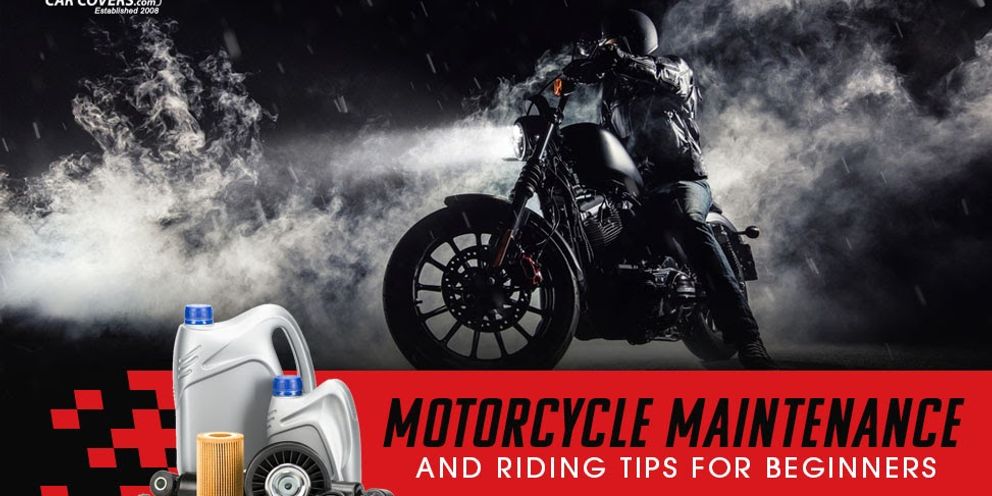
Motorcycle Maintenance and Riding Tips for Beginners
Whether you’re a seasoned rider or a novice, you understand the undeniable thrill of hopping on the back of a bike with the wind in your hair and the wide open road in front of you. Coupled with their relatively low-maintenance appeal and the fact that they can seriously crush many cars in terms of gas mileage, it isn’t hard to see why motorcycles are more popular than ever before. In fact, nearly 1.5 million Americans have added two-wheelers to their fleet in the past four years.
But just because they’re relatively easy to maintain, it doesn’t mean motorcycles are maintenance-free. In fact, they’re like any other vehicle in that they need routine tune-ups, oil changes, and inspections in order to cruise at their very best. Luckily, maintaining a motorcycle is surprisingly easy, and many of the tasks are ones you can do yourself in your own garage.
The Link Between Riding and Maintaining
In this guide, we’re going over all the most important motorcycle maintenance and riding tips for beginners. Though they seem like two very separate topics, riding and maintaining your bike are closely linked. Proper riding technique translates to a longer life on the road, while a solid maintenance schedule helps ensure that every ride is enjoyable and safe. Follow this detailed guide from CarCovers.com for some insight into how to ride and maintain your bike like a well-oiled pro, even if you’re rusty or a novice.
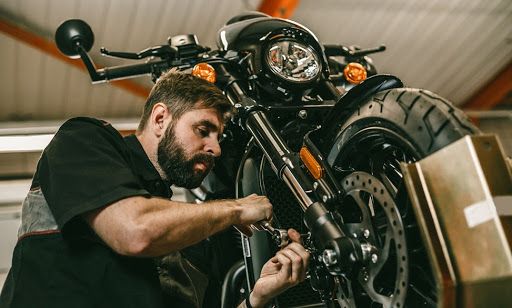
Weekly or Monthly Maintenance
For most Americans, peak riding season is between April and October, give or take a few weeks. These are the months when you’re probably breaking out the bike every day or at least several times per week. These are also the months when you need to keep a weekly maintenance schedule to ensure that you’re on top of even the smallest things. Here are a few things to do on a weekly or monthly basis when you’re riding often.
- Keep It Covered – When the weather’s nice, it can be tempting to park our toys out in the open, but this is just as bad a time to do that as during the winter because the sun and heat can take a serious toll on your bike’s exterior paint and finish. You want to find the right motorcycle cover for your bike and make sure it fits properly. Take it with you on long-distance rides so you don’t have to keep it exposed.
- Give It a Deep Clean – Weekly cleaning is key to ensuring that the exterior of your bike looks spiffy as you’re reaching top speeds on your favorite backroads. Motorcycles need to be cleaned more frequently than cars because they’re entirely exposed to the elements. Bugs, moisture, dirt, and debris can settle on the surface of your motorcycle, which can cause permanent scratches and damage. Build in weekly cleans for the best results.
- Inspect Your Tires – This one is especially important for those who use their bike as a long-distance vehicle or a daily driver. Many people don’t realize it, but motorcycles tires aren’t built to last as long as regular car tires, so paying close attention to them is important. Each week, be sure to inspect your tires for defects, check tire pressure with a tire pressure gauge, and use the penny test to check your tread depth. If your air pressure is low, be sure to add air. If you spot defects or have low tread, consider replacing your tires ASAP.
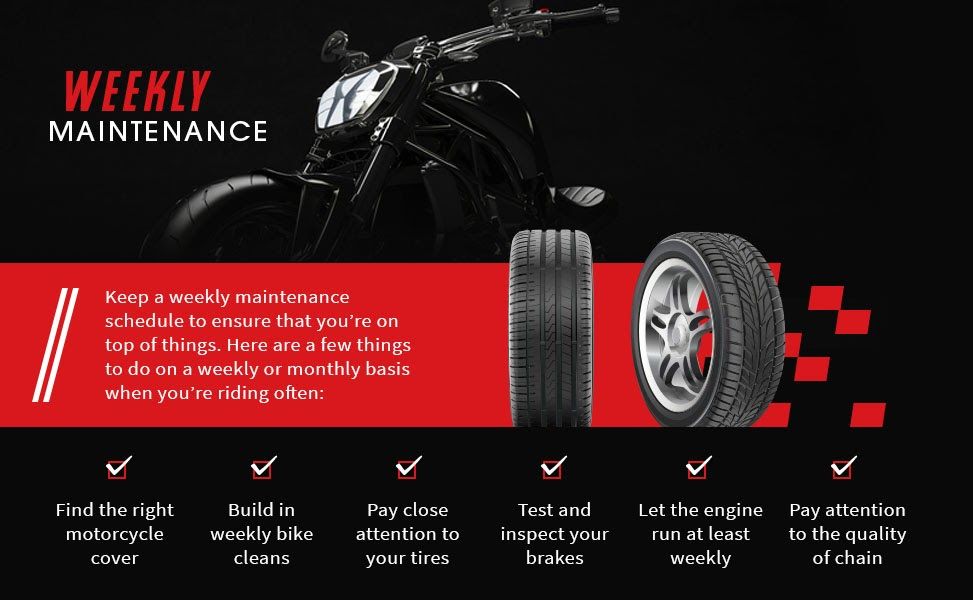
- Test and Inspect Your Brakes – It’s never a bad time to check your brakes. If you’re riding your bike daily or plan to head off on a longer trip—say, more than 15 miles from home—then you want to make sure you do a quick brake check at a slow speed before hitting the road at top speeds. Visually inspect your brake pads and make sure the friction lining is still in good shape.
- Take It Around the Block – You want to aim to drive your motorcycle at least 3,000 miles per year to ensure that it gets the appropriate amount of drive time to thrive. But it’s important to remember to spread these miles out across the year so parts don’t rust or atrophy in the garage. In the off season, you need to remember to break out your motorcycle and let the engine run at least weekly or twice a month to keep everything running properly.
- Perform Chain Maintenance – Pay close attention to the quality and condition of your motorcycle’s chain. On occasion, you will need to clean and lubricate it to ensure that it works at its best. Regular motorcycle chain maintenance can greatly lengthen the life of your chain and sprockets, so it’s not something you should overlook. Aim to clean your chain once every 300 to 500 miles.
Find the Right Motorcycle Cover for Your Bike
Twice a Year or Every 2,000 Miles
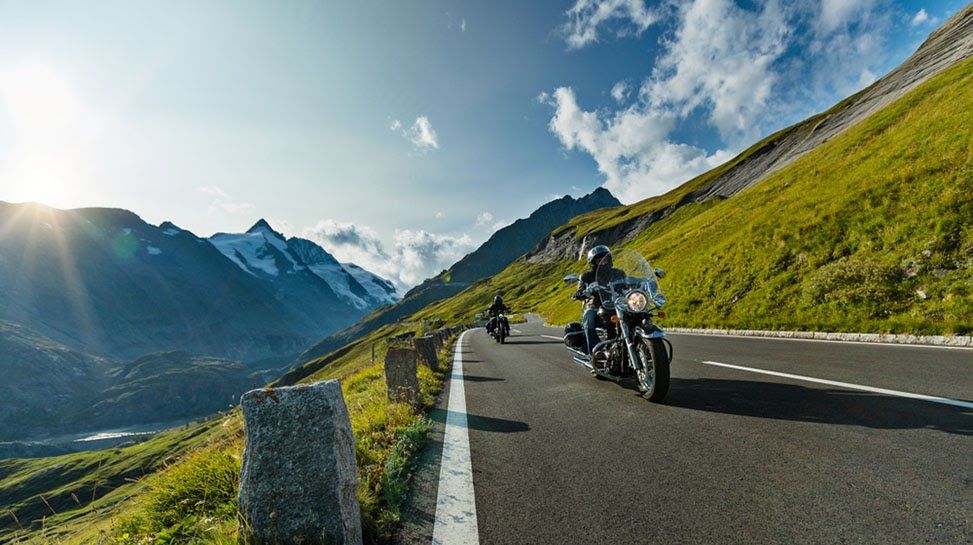
How often you do the following tasks will depend on how many miles you ride per year. Research shows that the average mileage for motorcyclists each year varies widely, depending on the rider, the bike, and its purpose. In other words, different types of motorcycles tend to get different levels of wear and tear. Standard bikes tend to get somewhere around 2,000 or 3,000 miles per year on average, while touring bikes will clock in at closer to 5,000 or 6,000.
With this in mind, the frequency at which you perform the following maintenance tasks will depend entirely on how much you drive your bike. If you’re on the lower end and tend to only ride about 2,000 miles per year, you will only need to do these tasks on an annual basis. However, if you’re taking a long-distance road trip or intend to make your bike your main ride this year, it’s best to do these tasks twice per year or more.
- Get an Oil Change and Change Your Air Filters – Check the owner’s manual of your specific motorcycle to find out how often you need to change your bike’s oil. A good rule is to get yours changed every 2,000 to 3,000 miles, but you may be able to get away with oil changes less often than that, depending on which kind of oil you choose and how much wear and tear your bike gets. This is also a good time to change your air filters.
- Top Off Other Fluids – Oil isn’t the only liquid you need to keep your bike in road-worthy condition! Every few thousand miles, you also want to top off other fluids, such as brake fluid and coolant. Often, your oil change mechanic will do this for you, but it’s helpful to have a few bottles on hand so you can top them off yourself when they get low. Lubricating your control cables with hydraulic cable oiler is a great way to prolong the life of your bike.
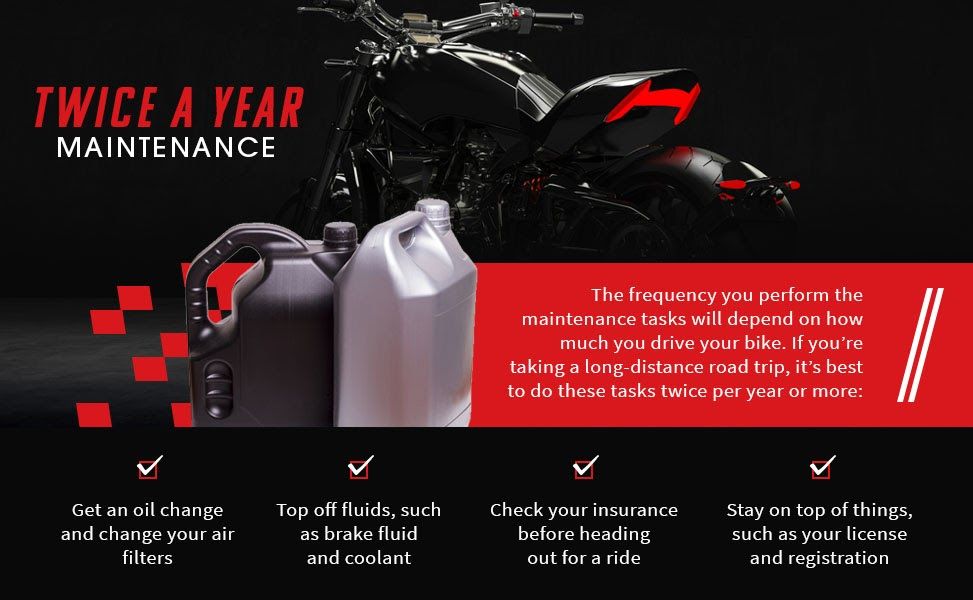
- Check Your Insurance – If you only ride your bike on a seasonal basis, it’s easy to forget that you need to keep it insured year-round. Luckily, there is something called motorcycle lay-up insurance, which covers you against theft and other situations when your motorcycle is in storage during the winter. Check your insurance standing before heading out for your first ride of the season.
- Check Your Registration – Again, since your bike probably isn’t your year-round driver, you need to stay on top of things that are easy to forget, such as your license and registration. Depending on where you live, you may have to register your motorcycle license annually or every two or three years. Check with your state’s bureau of motor vehicles to learn your local laws.
Yearly Maintenance or Every 4,000 Miles
There’s a good chance that if you’re a casual rider or someone who only breaks out the bike for a few months a year, you’ll be able to get away with performing the following maintenance tasks once every two or three years. However, if you tend to reach 4,000 miles per year, it’s best to keep them occurring on an annual basis to keep your bike in its best possible shape.
- Replace the Brake Pads and Rotors – Just like your car, you need to keep an eye on the condition of your motorcycle brake pads to ensure top-level safety and performance. Visually inspect the pads and their friction lining. If they appear to be slimmer than an eighth of an inch, it’s time for new brake pads. Note that you may not need to replace the pads for your bike’s front and rear wheels at the same time since they tend to wear at different speeds.
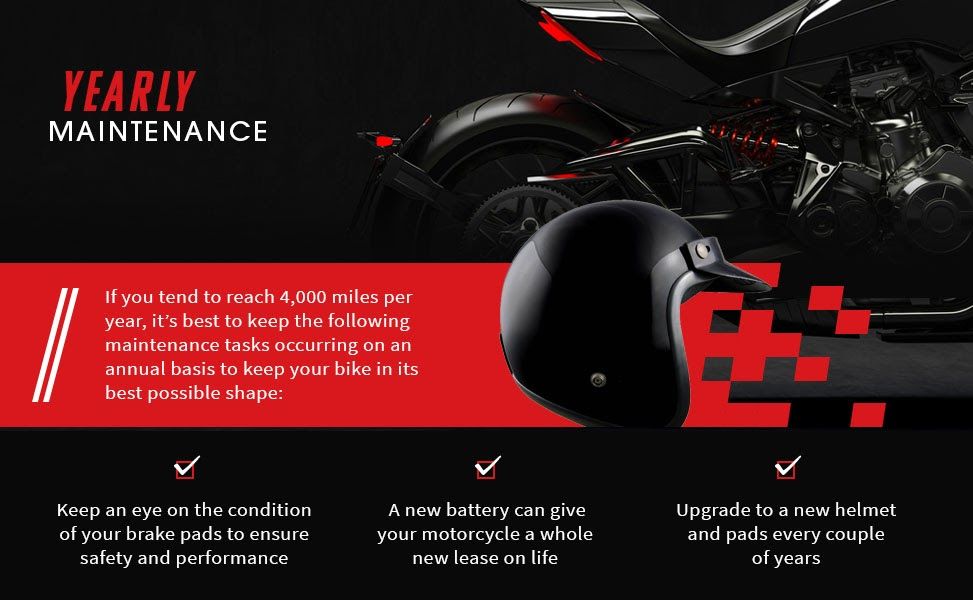
- Replace the Battery – Your motorcycle battery is responsible for many key safety and mechanical functions, and a new one can give yours a whole new lease on life. Luckily, motorcycle batteries are pretty long-lasting, and you probably won’t need to swap yours out more often than every two years. This is a relatively easy job that you can do yourself without the help of a professional.
- Get a New Helmet and Safety Gear – We can’t stress this enough: Make sure you always have comfortable safety gear so that you want to wear it the entire time you’re riding. Upgrading to a new helmet and pads every couple of years can help ensure that your gear remains in good shape and keeps you safe regardless of how often, and in what conditions, you ride.
Maintenance-Focused Riding Tips for Beginners
Your riding technique will greatly affect how long all your bike’s individual parts—and your bike as a whole—will remain on the road. The ability to push top speeds and weave in and out of traffic at your whim are major appeals of riding a motorcycle, but you don’t want to ride it too roughly or you’ll risk breakdowns and extra maintenance. Here are some simple tips for beginners:

- Don’t overdo it on the high speeds. Going too fast for too long isn’t just dangerous for you and your fellow motorists, but it’s bad for your bike and can lead to premature aging of your brakes and engine. Accelerating too suddenly or too hard is also a bad idea and can add additional wear and tear.
- Go easy on your brakes, as the harder and more suddenly you brake, the more often you’ll need to replace your brake pads and rotors.
- Know how your bike is supposed to sound so that you can identify any potentially concerning sounds while you’re in motion.
- Let your bike warm up for a couple of minutes before taking it out for the first time after it has been sitting in the garage for a while. This allows the oil to flow through the system and get lubricated while raising the bike to an ideal temperature so it’s ready to roll.
- Stick to the “nicer” roads. We know this can be tough in certain areas where potholes and road work are impossible to avoid, but don’t underestimate how much damage a poorly maintained road can do to your bike.
- Follow proper break-in protocol. If you’re investing in a new bike, make sure you follow the manufacturer’s break-in protocol. This may require you to keep the engine speed and revs to a minimum for a few hundred miles.

We’ve Got You Covered
Want to lengthen the life of your motorcycle? At CarCovers.com, we’ve got you covered (quite literally). Investing in the proper motorcycle cover is one of the absolute best ways to keep your two-wheeler in excellent shape for many more miles. Ours are the best of the best for the off season, evenings, and storage, so you can rest assured your bike is in good hands when it’s not in the control of yours.
Updated